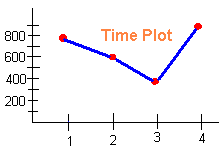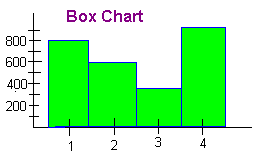Math
201
Practice
Exam I
Please work out each of the given
problems. Credit will be based on
the steps that you show towards the final answer.
Show your work.
Problem 1 Categorize these measurements associated with Lake Tahoe according to level:
nominal, ordinal, interval, or ratio.
-
The depth of clarity of the lake.
-
The time at which the first boat passes through from the Keys.
-
The type of fish that is the first to be caught in the morning.
A. Ratio, It makes sense to say that the depth has decreased by a factor of two.
B. Interval, It makes sense to say that today's time was 15 minutes later than yesterday's, but it does not make sense to say that the time was twice yesterday's.
C. Nominal, possible outcomes are Cutthroat, Kokanee, Rainbow, etc. which are qualitative.
Problem
2
You are interested in finding out the average number of classes that students take at LTCC. Since you can't find out this information for every student, you have all instructors who teach at 10:00 AM and at 2:00 PM survey all of their classes.
A. Is this a random sample? Explain your reasoning.
B. What type of sampling is this?
A. No, for example, none of the students will be night students who are less likely to take a full load.
B. This is cluster sampling since all of two times are surveyed.
Problem 3
A. You did research to determine the number of snow boarders who rode Sierra each Wednesday in January. You came up with the following data.
| Week | 1 | 2 | 3 | 4 |
| No. of Boarders | 800 | 600 | 400 | 900 |
Construct a time series plot and a bar chart for this data.


Problem
4
You are interested in the distribution of tree size in the Lake Tahoe basin. You take a random sample of 24 trees and measure their diameters (in inches). Below is the data that you collected.
0 3 4 4 6 7 8 8 9 10 10 10 11 12 14
16 17 19 24 24 29 30 34 39
A. Make a frequency table and histogram for this data. Use 4 class intervals
We make the class intervals 0-9 10-19 20-29 30-39
| Class | 0-9 | 10-19 | 20-29 | 30-39 |
| Frequency | 9 | 9 | 3 | 3 |
B. Make a Stem and Leaf Display of this data.
0 || 0 3 4 4 6 7 8 8 9
1 || 0 0 0 1 2 4 6 7 9
2 || 4 4 9
3 || 0 4 9
C. Describe the distribution of the data using the language of statistics.
The distribution is skewed to the right.
D. If a 25th tree was found to have a diameter of 48 inches would the standard deviation increase or decrease. (Answer this without calculating)
It would increase, since the standard deviation measures the spread of the data, adding a 48 would increase the spread. (48 is clearly very far from the mean.)
E. In what percentile is the tree that has a diameter of 7 inches?
There are 24 in the sample and there are 6 at or below the number 7. We compute
6
100% = 25th percentile
24
Problem 5
Twenty students were asked how far they travelled each day to get to the college. Nineteen of the students all traveled between 0 and 7 miles, but one student lived in Sacramento and traveled 100 miles each day.
A. Which of the following would be changed significantly if the student from Sacramento had not been surveyed: mean, median, mode, standard deviation, variance, midrange?Solution
The mean, standard deviation, and variance, midrange are all affected by outliers. The median is not significantly affected.
B. Suppose that the student from Sacramento had not been surveyed and that the mean was calculated to be 3.2 and the standard deviation was 0.9. Use a sentence or two to interpret the standard deviation in the context of the study.
Solution
Since the mean is 3.2 and the standard deviation is 0.9, we can say that generally much of the data most likely lies within one standard deviation of the mean (empirical rule). Subtracting 0.9 from 3.2 gives 2.3 and adding 0.9 to 3.2 gives 4.1. Thus a good percent of the students travel between 2.3 and 4.1 miles to the college each day.
Problem 6
Last year, 2,000,000 Kokanee Salmon hatched in Taylor Creek. Of those, only 20,000 reached to one year. 12,000 of the survivors were female.
A. What is the estimated probability that a hatched egg will live for at least one year?
20000/2000000 = .01
B. What is the estimated probability that a Kokanee that lives to one year will be female?
12000/20000 = .6
C. What is the estimated probability that a hatched egg will live for at least one year and will be female?
12000/2000000 = .006
D. Estimate the probability that a hatched egg will die before it reaches one year old?
We use the property of complements
P(Not living 1 year) = 1 - P(living 1 year) = 1 - .01 = .99
Problem 7
You roll two fair six sided dice.
A. What is the probability that the sum of the two dice is four?
The sample space has 36 elements (six possibilities for each die). You can get a four by
1 and 3, 3 and 1, and 2 and 2
hence
P(Sum = 4) = 3/36 = 1/12
B. What is the probability that the sum of the two dice is a nine given that the first die was a six?
Since we are given the value of the first die, we only need to determine the second die. There are 6 values for the second die. The only way to roll a sum of nine while the first die shows a six is for the second die to be a 3. We have
P(Sum = 9| First = 6) = 1/6
C. What is the probability that the sum of the two dice is larger than 3?
The easiest way to do this one is to use complements.
P(Sum > 3) = 1 - P(Sum < 3) = 1 - P(Sum = 3) - P(Sum = 2)
The only way to roll a sum of 3 is
1 and 2 and 2 and 1
hence
P(Sum = 3) = 2/36
The only way to roll a sum of 2 is
1 and 1
hence
P(Sum = 2) = 1/36
We compute
1 - P(Sum = 3) - P(Sum = 2) = 1 - 2/36 - 1/36 = 33/36 = 11/12
Problem 8
In your collection of nine pens you know that three are out of ink. Since you are in a rush to get to your midterm, you randomly select two of the pens (a blue one and a black one). Determine the probability that exactly one of the pens is out of ink.
First notice that there are two ways that this can happen. The first way is that the fist chosen pen is out of ink and the second has ink. The second way is that the first chosen pen has ink and the second is out of ink. Let's first find the probability that the first is out of ink and the second has ink. By the multiplication rule, we have
P(First is out of ink and the second has ink) = P(First is out of ink) P(Second has ink | First is out of ink)
= (3/9)(6/8)
= 1/4
We got 6/8 based on the fact that after the first pen is chosen out of ink, there are 6 pens with ink, but only 8 total pens left. Now lets find the probability that the first has ink and the second is out of ink. Again by the multiplication rule, we haveP(First has ink and the second is out of ink) = P(First has ink) P(Second is out of ink | First has ink)
= (3/9)(6/8)
= 1/4
Since these are mutually exclusive, we can add the probabilities to get our final answer
P(Exactly one of the pens is out of ink) = 1/4 + 1/4
= 1/2
Problem 9
Determine the probability of getting a Royal Flush in Poker (5 card stud). (Recall that a Royal Flush is Ace King Queen Jack and Ten all in the same suit. Also recall that there are 52 cards in a deck and a poker hand has five cards.
There are four ways to get a Royal Flush (one for each suit). We use combinations to find the total number 5 card hands. We have
C52,5 = 2,598,960
The probability is
P(Royal Flush) = 4/2,598,960 = .0000015
Extra Credit: Write down one thing that your instructor can do to make the class better and one thing that you feel that the instructor should continue doing.
(Any constructive remarks will be worth full credit.)